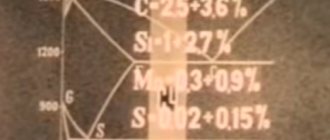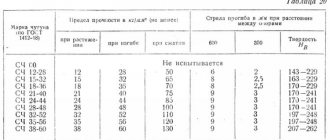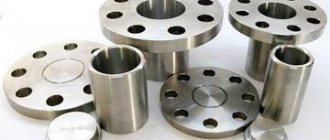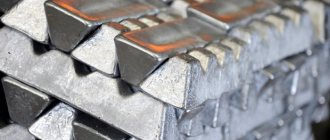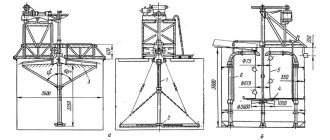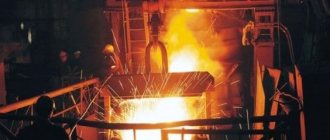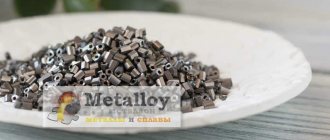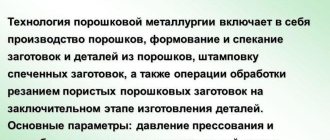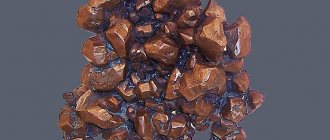Types of produced white cast iron
Depending on the crystalline structure, as well as the presence and ratio of the constituent elements, white cast iron is divided into:
- ordinary;
- alloy;
- heat resistant;
- stainless.
A separate type is cast iron alloys with high electrical resistivity.
The internal structure of ordinary white cast iron contains carbon in the form of cementite grains. The amount of carbon affects the melting point and, depending on this, cast iron is divided into:
- hypoeutectic with a lower melting point, carbon not more than 4.3%;
- eutectic with a carbon content of 4.3%;
- hypereutectic - more than 4.35% and can reach - 6.3%.
The effect of cast iron bleaching is achieved by rapidly cooling the casting, which as a result is heterogeneous in composition. The top layer, up to 30 mm thick, becomes white, and the rest of the core is ordinary gray cast iron.
Types of annealing
To form white cast iron, industry uses rapid cooling of the alloy. Today, the following main types of carbon alloy annealing are actively used:
- softening annealing is used primarily to increase the ferrite content of cast iron;
- annealing to relieve internal stresses and minimize phase transformations;
- graphitizing annealing, as a result of which it is possible to obtain malleable cast iron;
- normalization at a temperature of 850-960 degrees, resulting in graphite and perlite, and also increases wear resistance and strength.
Advantages and disadvantages
Like all cast iron alloys, white ones are distinguished by great strength combined with brittleness under strong mechanical shocks. Among the main positive qualities of white cast iron are:
- high hardness;
- high resistivity;
- wear resistance;
- increased corrosion resistance.
An important quality of white cast iron is considered to be very good resistance to high temperatures, which is used to reduce the number of cracks in initial castings.
The main disadvantages include such qualities as:
- fragility and the possibility of destruction under mechanical stress;
- low casting qualities and poor mold filling;
- the likelihood of internal cracks forming during casting;
- complex and low-quality mechanical processing.
Formation of defects during welding due to the rapid burnout of carbon and the formation of pores.
Structure and composition
If we consider cast iron as a structural material, then it is a metal cavity with graphite inclusions. The structure of cast iron is mainly pearlite, ledeburite and ductile graphite. Moreover, for each type of cast iron these elements predominate in different proportions or are absent altogether.
According to the structure of cast iron there are:
- perlite,
- ferritic and
- ferritic-pearlitic.
Graphite is present in this material in one of the forms:
- Globular. Graphite takes on this shape when magnesium is added. The spherical shape of graphite is characteristic of high-strength cast irons.
- Plastic. Graphite is similar to the shape of petals. In this form, graphite is present in ordinary cast iron. This cast iron has increased ductility properties.
- Flaky. Graphite acquires this shape by annealing white cast iron. Graphite is found in flake form in malleable cast iron.
- Vermicular. The named form of graphite is found in gray cast iron. It was developed specifically to improve ductility and other properties.
Influence of impurities on material properties
The components that make up cast iron affect the quality of the alloy:
- sulfur helps reduce the refractoriness and fluidity of cast iron;
- phosphorus reduces strength, but makes it possible to vary the shape of finished products;
- silicon reduces the melting point of the metal and enhances its casting properties. In addition, this element makes it possible to obtain alloys of different colors: from pure white to ferritic;
- manganese gives cast iron strength and hardness, but reduces the casting and technological properties of the finished material;
- the introduction of titanium, aluminum, chromium, nickel or copper into the composition allows the production of alloyed alloys. They have high casting qualities and have proven good machinability. Production technology
Cast iron cast in the form of pigs
The source of raw materials for metallurgists is iron ores (rocks with a predominance of iron in the composition).
The ore is sent to processing plants, where part of the “empty” material is removed from the raw material.
The resulting material is transported to the metallurgical plant.
Here they are loaded into blast furnaces:
- Fuel is added - coke (a product of processing coal), limestone, briquetted coal dust.
- Melts at high temperatures.
- During the reduction process, iron with carbon embedded in its structure is obtained from oxides.
As a result of smelting, cast iron and slag are formed (a mixture of fuel ash, unused fluxes, and other products).
Ligatures are added if necessary. They determine the physical and chemical properties of the material.
Production is simple, but environmentally dirty.
Application area
Ordinary white cast iron is used very limitedly, since it is poorly applicable to mechanical and heat treatment. For the production of products it is often used in the form of unprocessed or partially processed castings.
The alloy is most widely used in the manufacture of large parts of simple configuration. These are housings and parts of machine tools and rolling mills, balls for mills, drive and support wheels. In addition, white cast iron is used for the manufacture of assembly units that are constantly exposed to abrasive materials.
An important point is the use of ordinary cast iron as a raw material for the manufacture of malleable grades of iron-carbon cast iron and steel alloys.
What is gray cast iron?
The corresponding type of cast iron is one of the most common in the field of mechanical engineering. This metal is characterized by the presence of plate-shaped graphite in the thin section. Its content in gray cast iron may vary. The larger it is, the darker the metal becomes at the fracture, and also the softer the cast iron. Castings from the type of metal in question can be produced in any thickness.
Main features of gray cast iron:
- minimum relative elongation - as a rule, not exceeding 0.5%;
- low impact strength;
- low plasticity.
Gray cast iron contains a small percentage of fixed carbon - no more than 0.5%. The remaining part of the carbon is presented in the form of graphite - that is, in a free state. Gray cast iron can be produced on a pearlitic, ferritic, or mixed ferrite-pearlite base. The metal in question usually contains a significant percentage of silicon.
Gray cast iron is quite easy to process using cutting tools. This metal is used for casting products that are optimal in terms of compression resistance. For example, various supporting elements, batteries, water pipes. The use of gray cast iron is also widespread in mechanical engineering - most often in the manufacture of parts that are not characterized by shock loads. For example, housings for machine tools.
Alloying of white cast iron
The presence of alloying additives in the alloy greatly changes its physical properties, which significantly expand its scope of application. Very common substances are used as alloying elements in metallurgy.
To increase hardness, the following can be added to an iron-carbon cast iron alloy: nickel, phosphorus, manganese, chromium, vanadium, silicon, copper, titanium and sulfur.
In the event that the amount of alloying additives is approximately equal to the carbon content, cast iron acquires the maximum possible hardness.
Wear resistance, as a physical characteristic of white cast iron, is considered regardless of its hardness. Its increase is achieved by changing the structure of the metal by adding carbides and phosphides in the form of evenly distributed inclusions. The quality of casting parts directly depends on the chemical composition of the alloys and the amount of alloying elements.
Depending on the percentage of alloying impurities, white cast iron is divided into:
- low alloyed up to 2.5%;
- medium alloyed up to 10%;
- highly alloyed.
Already finished cast iron castings are subjected to additional temperature treatment (annealing), as a result of which the internal stresses of the metal are relieved and the external dimensions are stabilized. The annealing temperature of white alloy cast iron is about 850°C.
The heating and cooling process occurs slowly to prevent the formation of internal cracks and other defects.
Alloy cast iron alloys are widely used in production:
- parts of industrial equipment and machine tools;
- components and parts of cars, tractors and agricultural machinery;
- rolling stock; pipes, pumps, boilers;
- household and household products.
This is due to the improved qualities of the metals compared to ordinary white cast iron.
Features of receiving
When producing white cast iron, it is important to exclude the graphitization process during crystallization of the melt, which is done:
- optimal selection of starting substances;
- technology for cooling the alloy in molds.
The degree of wear resistance of castings is largely determined by the nature and composition of carbides. Alloying the metal with nickel, manganese and chromium gives a martensitic carbide structure. When their total concentration is equal to the carbon content, the hardest structure is formed.
Most often, chromium is used as the main alloying additive. It gives the alloy high corrosion resistance, which is maintained even in aggressive environments. After normalization, these blanks are resistant to acids at temperatures up to 1000 degrees. Additional alloying with nickel (0.1%), titanium (0.5%) and copper (0.5-2.0%) gives the parts the ability to maintain their geometric shape and original dimensions under prolonged heating conditions.
Stainless alloys
To increase the resistance of white cast iron to corrosion, large amounts of chromium are added to it. This leads to the formation of an oxide film on the surface and further cessation of oxygen access. In addition, high-chromium white cast iron becomes resistant to alkaline solutions, sulfuric and nitric acid.
Additionally, the process of alloying with chromium prevents the possibility of coagulation of carbides when the alloy is heated strongly. This allows you to obtain high-quality welded joints of parts made of white cast iron. If nickel and molybdenum are added along with chromium during the alloying process, the resulting stainless alloy can be compared in strength to the best heat-resistant steels, which are much more expensive.
Chromium-containing white cast iron is used in cases of severe operating conditions, the presence of alkalis and oxidizing agents, and the need for high electrical resistance.
Alloying substances, marking
According to GOST, alloy cast iron must contain a certain amount of substances for use in a certain area. In addition, the markings are also standard. For example, ChN15D7X is a high-strength alloy that contains 15% nickel, 7% copper and approximately 1% chromium. As you can see, in the marking alloying elements are marked with one letter, followed by a number indicating the quantitative content of the additive. However, it may also be that the number is missing, as after chrome. This means that the content of the substance in the composition is about 1%.
As for the production of such cast iron, it is quite inexpensive. At the same time, the final product has fairly high performance properties. Thanks to these two factors, the scope of application of the described material is constantly increasing.
